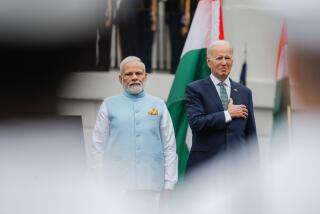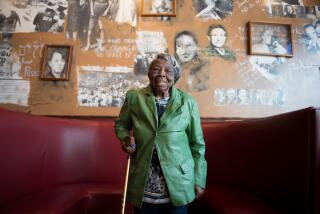In India, Obamas join the dance
- Share via
Reporting from Mumbai, India — A group of schoolchildren enticed President Obama to join them in a traditional Indian dance during a Diwali celebration on Sunday, inspiring some low-key moves mostly unrelated to the elaborate steps everyone else was doing.
First lady Michelle Obama turned in an enthusiastic performance of the Kholi dance, however, imitating the wide arm swings of the children and basking in their attention for several minutes.
Later in the day, the president spent almost two hours under a baking sun telling college students that the U.S.- India relationship can and should be a “two-way street.” The students grilled him — and drew some controversial remarks about Pakistan, where the 2008 terrorist attacks on Mumbai were planned — but as they left several gave him high marks for his willingness to engage.
But it was in their few moments of spontaneous dance that the Obamas drove home the day’s message, generating imagery that immediately began playing and replaying on Indian television.
“She was moving,” the president said of his wife later.
Simpatico between President Obama and his audience on this trip is not a given. Though he usually enjoys a warm rapport with young people when he travels, he faces hurdles in his efforts here — starting with the one back home, the fact that many Americans think of this region as the competition for jobs.
Over the weekend in India, Obama has peddled a message of “enormous untapped potential” in trade, but he combined it with calls for India to lower trade barriers in everything from retail to telecommunications. Some listeners are skeptical, aware that Obama and other Democrats often speak disapprovingly of U.S. companies that “ship jobs overseas.”
“It is offensive,” said Lopa Mullick, a young entrepreneur who owns an events management company. “It hurts us, to an extent. You’re not looking at all the opportunities that India has created for the U.S., at the economic benefits both sides get.”
Still, she said, she turned out for Obama’s speech at the Xavier College campus because she believes Obama can “shift the focus,” and that he may actually want to do so.
At Xavier, the students gave Obama a warm but skeptical reception. They asked a range of philosophical questions — one woman noted Obama’s public admiration for Mahatma Gandhi and asked which of Gandhi’s teachings he finds most important — but quickly turned to a tough round on foreign policy.
One student asked about the U.S. government’s negotiations with the Taliban in Afghanistan, and another wanted to know why he doesn’t declare Pakistan a terrorist state. Obama defended his administration’s efforts to work with the Pakistani government to root out extremism within its borders. He urged Indians to set aside their longstanding hostility and promote their neighbor’s stability, as well.
Some students said they agreed with Obama, some disliked his answer. Television talk shows debated the question throughout Obama’s stay in Mumbai.
But if there is skepticism of his policies, said one professor, Obama still has standing to reach across the divide. His overtures this week have been well-received, said Kishu Daswani, professor at the Government Law College here.
“He’s come from humble beginnings, and risen to be the most powerful man in the world,” Daswani said. “That’s a story people understand and like.”
Like the Nehru, said Daswani, Obama seems to know the power of winning people over by respecting their customs and traditions.
“And that includes dance,” he said.
On that point, Michelle Obama may be the mission’s leading spokesperson right now. In a visit with schoolchildren the first day of her visit, she broke out into a lengthy dance that dominated TV and inspired local newspaper headlines like “When Michelle Got Into the Groove.”
Ironically, as they planned the trip, White House staffers worried that security logistics would make it hard for the president to interact with Indians outside the town halls and summits. With the first lady already dancing around the Holy Name High School on Sunday, however, it was easier for the students to also pull Obama into their circle.
“I thought it was wonderful,” said Mohini Bhattacharya, a graduate student in microbiology. “It’s a sign that they want to interact with us.”
More to Read
Sign up for Essential California
The most important California stories and recommendations in your inbox every morning.
You may occasionally receive promotional content from the Los Angeles Times.











